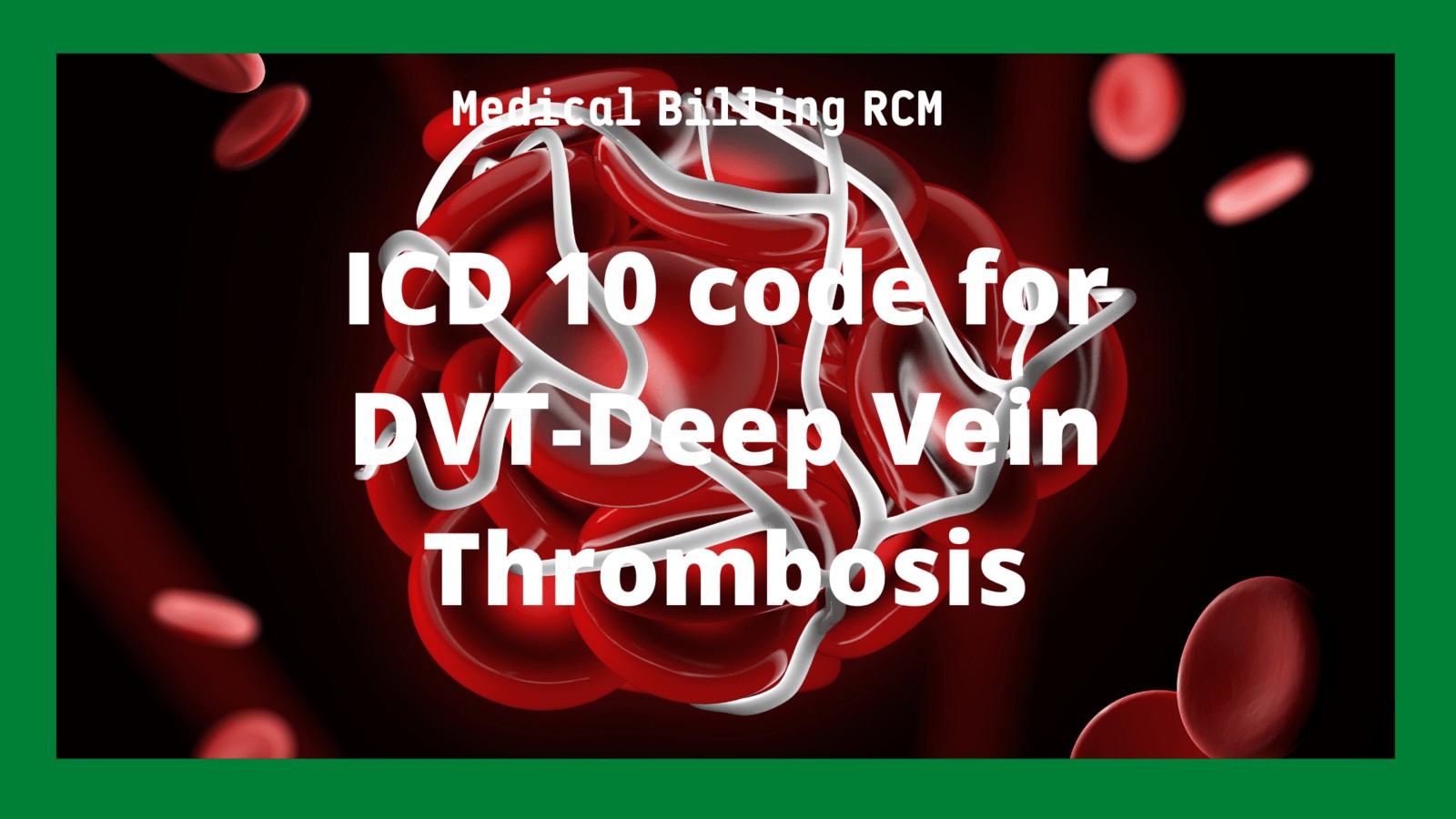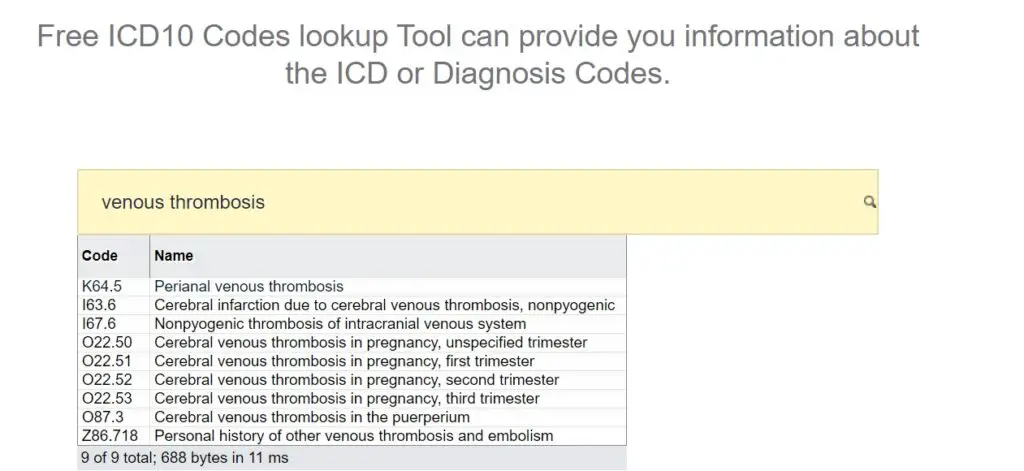DVT stands for Deep Vein Thrombosis. The creation of a blood clot in a deep vein of the leg or lower pelvis. Symptoms may include pain, swelling, warmth, and redness in the affected area. In this article, we know more about the ICD 10 code for history of DVT and related ICD 10 codes that we are using in our claims.
Most of the time a blood clot is created in the legs if someone doesn’t move for a long time. Sometimes it is developed due to long bed rest due to surgery, any illness, or any reason.
DVT can be a serious disease because blood clots in the veins can break loose. The clots in the blood can then travel through the bloodstream and get stuck in the lungs, blocking blood flow, etc. When DVT and Pulmonary Embolism develop together, it is called Venous Thromboembolism (VTE).
ICD 10 Code for History of DVT:
We can use the ICD 10 code for the History of DVT is Z86.718.
Other related ICD codes for DVT
| ICD Codes | Description |
| Z86.39 | Personal history of other endocrine, nutritional and metabolic disease |
| Z86.5 | Personal history of mental and behavioral disorders |
| Z86.51 | Personal history of combat and operational stress reaction |
| Z86.59 | Personal history of other mental and behavioral disorders |
| Z86.6 | Personal history of diseases of the nervous system and sense organs |
| Z86.61 | Personal history of infections of the central nervous system |
| Z86.69 | Personal history of other diseases of the nervous system and sense organs |
| Z86.7 | Personal history of diseases of the circulatory system |
| Z86.71 | Personal history of venous thrombosis and embolism |
| Z86.711 | Personal history of pulmonary embolism |
| Z86.718 | Personal history of other venous thrombosis and embolism |
| Z86.72 | Personal history of thrombophlebitis |
| Z86.73 | Personal history of transient ischemic attack (TIA), and cerebral infarction without residual deficits |
| Z86.74 | Personal history of sudden cardiac arrest |
| Z86.79 | Personal history of other diseases of the circulatory system |
| Z87 | Personal history of other diseases and conditions |
| Z87.0 | Personal history of diseases of the respiratory system |
| Z87.01 | Personal history of pneumonia (recurrent) |
| Z87.09 | Personal history of other diseases of the respiratory system |
| Z87.1 | Personal history of diseases of the digestive system |
| Z87.11 | Personal history of peptic ulcer disease |
What is DVT in Medical terms?
Deep vein thrombosis (DVT) stands as a medical enigma, and its intricacies are woven within the fabric of our vascular system. It manifests as a condition where blood clots, known as thrombi, materialize within the profound recesses of our veins, predominantly taking root in the lower extremities. The lower leg, the calf, or even the mighty thigh may become the clandestine battlegrounds where these treacherous formations thrive. However, they also possess the audacity to encroach upon other venous territories.
The genesis of DVT often finds solace in the arms of certain predisposing factors, their embrace contributing to the symphony of its existence. Prolonged immobility, a wicked dance partner accompanying sedentary lifestyles, becomes a potent ally in DVT. Hours spent in uninterrupted repose, be it on an intercontinental flight or the confines of a bed, bestows upon this condition a fertile ground to blossom.
Surgery and trauma, heralding a meaningful assault on the human body, unfurl as another catalyst in forming these malevolent clots. The extremities, particularly vulnerable in the face of such surgical endeavours, bear witness to the sinister alliance between invasive procedures and DVT. The wounds inflicted by significant injuries echo a similar sentiment as if inviting these sanguinary enemies to their clandestine gathering.
Weight, an ever-present companion in the human journey, is a potent ally of DVT. Those bearing the burden of obesity or the label of being overweight find themselves entangled within the labyrinthine clutches of this condition. The body, seemingly helpless in its endeavours, succumbs to the weight of its existence, becoming an unwitting accomplice in the tale of DVT.
Pregnancy, a wondrous and transformative phase in a woman’s life, paradoxically becomes a harbinger of heightened risk for blood clot formation. The delicate balance of circulation and pressure within the maternal body undergoes an intricate dance, creating an environment conducive to the emergence of these sinister intruders.
Similar to a double-edged sword, hormonal factors wield their influence in the realm of DVT. The use of hormone replacement therapy or the consumption of oral contraceptives infused with estrogen, meant to empower and liberate, may unwittingly set the stage for this nasty condition. A delicate equilibrium teeters on the precipice of imbalance, and the repercussions are felt within the depths of our veins.
The passage of time, an inevitable companion on our journey through life, bequeaths upon us the spectre of age. With each tick of the clock, the risk of DVT looms larger, casting its sombre shadow upon those who traverse the realm of advancing years. The wisdom and experience accumulated may serve as a worthy adversary to the perils of life, but in the face of DVT, the battle becomes more formidable.
Within this realm of profound complexity, the symptoms of DVT emerge, each presenting a subtle variation on the canvas of human suffering. Swelling, an insidious companion, ensues in the affected leg, ankle, or foot, leaving a trail of discomfort in its wake. Pain, akin to a haunting nocturne, takes residence in the affected area, its melody resonating as a cramp or a deep ache. Warmth and redness, fiery tributaries coursing beneath the skin, become telltale signs of this hidden affliction. Like a roadmap etched upon the surface, enlarged veins bear witness to the profound battle that rages within. And yet, there are those cases of DVT that cloak themselves in silence, concealing their presence and rendering diagnosis a formidable task.
The stakes escalate when a blood clot within the deep recesses of a vein manages to break free from its shackles. A difficult journey ensues as it ventures into the tumultuous currents of the bloodstream, like a fugitive evading capture. The lungs, innocent bystanders to this odyssey, become unwitting hosts to the trespassing clot. Pulmonary embolism, a life-threatening condition, materializes in the wake of this intrusion, casting a dark shadow over the delicate balance of life.
In the face of such adversity, should one harbour suspicions of DVT or find themselves at risk, the beacon of medical attention must be sought with utmost haste. The unravelling of this enigma entails a meticulous dance between the healer and the afflicted. Physical examinations, probing the depths of the human vessel, interweave with the tapestry of medical history assessment. Diagnostic tests, bearing the weight of scientific prowess, such as ultrasound or venography, stand as sentinels in the quest for truth.
Treatment, a beacon of hope amidst the shadows, seeks to unveil a path to recovery. Blood-thinning medications, the guardians of coagulation, assume their role in preventing the growth of these intruders while simultaneously reducing the risk of complications. Yet, despite relentless adversity, supplementary interventions may be summoned from medicine’s arsenal. Compression stockings, like warriors encasing the limbs, strive to restore balance and alleviate the plight of the afflicted. Procedures, akin to daring manoeuvres on the battleground of the body, aspire to remove or dissolve the clot, unravelling the enigma that holds one captive.
Let the words weave a tapestry of complexity and depth within the realm of language and expression, embodying the perplexity and burstiness that befit the subject at hand. May the sentences dance, some adorned in elegance and intricacy, others embracing brevity and conciseness. In this symphony of words, let the true essence of the topic resonate, infusing the reader with knowledge and understanding.
Symptoms of DVT:
- Leg pain, cramping, or soreness
- Change in skin color on the leg like red or purple
- Swelling in leg
- A warmth feeling on the affected leg
Related Articles:
List of Diagnosis Related Groups- What is DRG Code
Hemorrhoids ICD 10 Code | What is Hemorrhoids Medication
99203 CPT Code Description and Reimbursement
- Eye Dryness icd-10 Code (2024)
- CPT for Punch Biopsy 11104 (2024)
- ICD 10 Code For Knee Pain-M25.56 (2024)
- Palpitations ICD10 Code – R00.2 (2024)
- ICD 10 Code For Lipid Panel (2024)
- HFREF ICD-10 Code – I50.20 (2024)
- ICD 10 Code For Pyelonephritis (2024)
- Neuropathy ICD 10 |Neuropathy Symptoms and safety (2024)
- AKI ICD 10 Code N17.9 (2024)
- Leukocytosis ICD 10 Code- D72.829 (2024)


